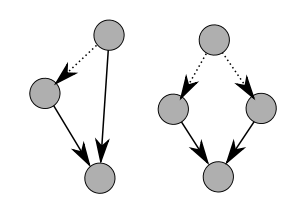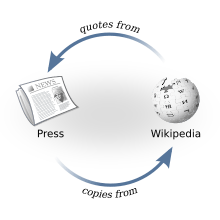Circular reporting

Circular reporting or false confirmation is a situation in source criticism where a piece of information appears to come from multiple independent sources, but in reality comes from only one source.[1][2] In many cases, the problem happens mistakenly through sloppy intelligence gathering practices. However, at other times the situation can be intentionally contrived by the original source as a way of reinforcing the widespread belief in its information.[3]
This problem occurs in a variety of fields, including intelligence gathering,[2] journalism, and scholarly research. It is of particular concern in military intelligence because the original source has a higher likelihood of wanting to pass on misinformation, and because the chain of reporting is more prone to being obscured. The case of the 2002 Niger uranium forgeries was a classic instance of circular reporting by intelligence agencies.[4]
Examples involving Wikipedia

Wikipedia is sometimes criticized for being used as a source of circular reporting.[5] Wikipedia advises researchers and journalists to be wary of, and generally avoid, using Wikipedia as a direct source, and instead focus on verifiable information found in an article's cited references.
In the following examples, false claims were propagated on Wikipedia and in news sources because of circular reporting. Randall Monroe, in his comic xkcd, coined the term "citogenesis" to describe this phenomenon.[6]
- Wikipedia and Der Spiegel in 2009, regarding Karl-Theodor Freiherr von und zu Guttenberg.[7]
- Wikipedia and The Independent in 2007, propagating the false information that Sacha Baron Cohen worked at Goldman Sachs.[8]
- Wikipedia on the coati beginning in 2008, when an arbitrary addition "also known as....the Brazilian aardvark" by an American student resulted in much subsequent citation and usage of the unsubstantiated nickname as part of the general consensus, including published articles in The Independent, The Daily Mail, and a book published by the University of Chicago.[9]
See also
|
|
- Media echo chamber
- Circular reference
- Ghost word
- Hoax
- Rumor
- Woozle effect
- Reliability of Wikipedia
- Wikipedia:List of citogenesis incidents
References
- ↑ Marcus Sterzer, CD; Patrick McDuff B.A. & Jacek Flasz (Summer 2008). "The Challenge of Centralized Control Faced by the Intelligence Function in Afghanistan" (PDF). Canadian Army Journal. Archived from the original (PDF) on 2012-03-05.
- 1 2 "The Cocktail Napkin Plan for Regime Change in Iran". Mother Jones. June 2008.
- ↑ Micheal T. Hurley; Kenton V. Smith. "8". I Solemnly Swear. p. 128. ISBN 0-595-29947-4.
Circular reporting occurs when what is reported is fed back to the originator in revised fashion which makes it difficult to objectively view the end product until you can trace back the sources to determine where the original information actually came from. Pan Am would eventually try to play that game by trying to introduce into court news reports that they themselves had a hand in producing.
Google Book search, retrieved on 23 July 2009. - ↑ Drogin, Bob; Hamburger, Tom (2006-02-17). "2006-02-17". Los Angeles Times.
This became a classic case of circular reporting," said a U.S. intelligence official who spoke on condition of anonymity because he is not authorized to talk to reporters. "It seemed like we were hearing it from lots of places. People didn't realize it was the same bad information coming in different doors.
- ↑ Timmer, John (May 2009). "Wikipedia hoax points to the limits of journalists' research". Ars Technica.
- ↑ "xkcd: Citogenesis". xkcd.com. Retrieved 2018-09-20.
- ↑ "Wie ich Freiherr von Guttenberg zu Wilhelm machte" (in German). BildBlog.de. 2009-02-10.
"False Fact On Wikipedia Proves Itself". Slashdot. 2009-02-11. - ↑ "Wikipedia Article creates Circular references". Tech Debug blog. 2009-01-14.
- ↑ "How a Raccoon Became an Aardvark". New Yorker. 2014-05-19.
- ↑ "How false news can spread - Noah Tavlin". TED-ED. August 27, 2015. Retrieved August 29, 2015.